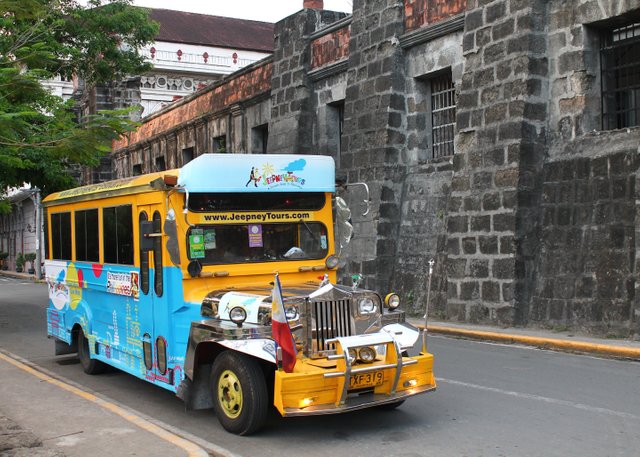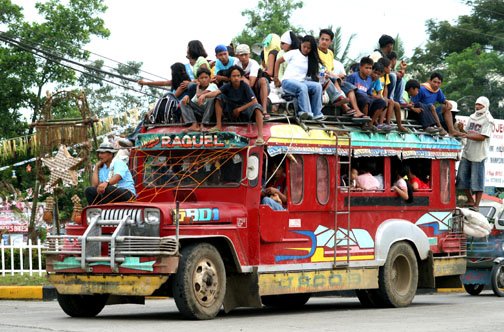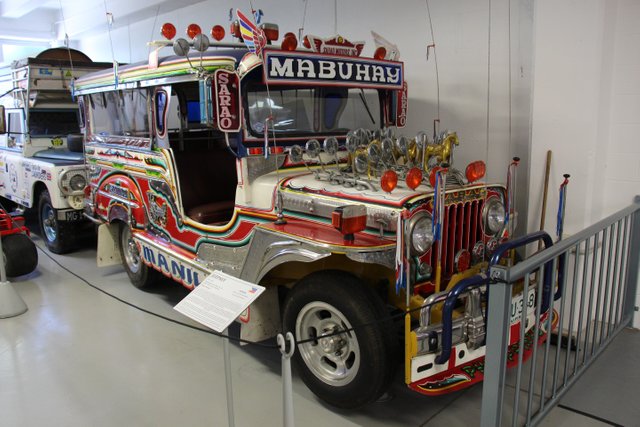
In the Philippines there is a public transport called a "Jeepney", it is a long diesel-powered and spruced-up version of the American World War 2 general purpose "(G.P.)" or Jeep hence the word Jeep was derived pertaining to these dependable vehicle that is now part of the culture and identity of the Philippines.
Jeepneys are the evolution of the US Army Jeep. The old Jeep changed with a metal roofing and adorned by then "Horses" on the hood of the car as a reminder of the horse-drawn carriage used by Filipinos before as a mode of transport before world war 2 began. The ingenuity of some Filipinos had turned the Jeep into a colorful Jeepney from a shorter version into a modern one with either A/C system or electrically powered or both.
Most are now decorated still by colorful images wanted to be done by its owner and you sometimes read some funny taglines pertaining to closing your legs to make room for others to sit inside.

Overloaded Jeepneys Are A Common Thing In Provinces
Src
In some provinces the Jeepney is the only mode of transport so they are scarce. In my grandmother's province the Jeep is loaded in the center and at the back where a person would take a small wooden seat and place it on the "estribo" or footrest in the entrance on the back if the center portion of the Jeepney is loaded already.
They also have a funny way of telling the driver to stop by clicking the metal armrest above which would signal the driver to halt because the passenger is ready to alight from the Jeepney when they reached their particular destination.

They often use the longer type of Jeepney for long travels where they have to get more passengers to make more profit out of the point to point destination of these longer and bigger Jeepneys.
A Regular Sized Jeepney Is Commonly Used In The Philippines
Src
This is the size of the Jeepney I grew up using for my transportation to and from the school and when I want to go elsewhere in town or even in the next province.
Now there is a talk in phasing-out these diesel-powered transport into a more eco-friendlier electric powered Jeepney which actually look like a small airconditioned bus because it is closed and the main entrance is on the front rather than the back. Like in what we see in the 1st and fourth photo.
Personally I do would like the phasing-out of these nostalgic mode of transport especially in the cities as they really are polluting the environment for the reason that they are too many of them in the streets.
But not all can afford to buy the modern Jeepney which costs an arm and leg so the owners of today's public Jeepneys are opposing the idea of a total ban and phasing out of the Philippine jeepney but in the future I guess that the law will prevail and the owners just have to abide by it.


Hola como estas, esos transportes si que son muy extraños pero se ven muy bien, y es importante ese transporte en algunas zonas para llevar a las personas, a veces es bueno los avances y los cambios pero sabes aquí en Venezuela al adquirir transporte los carros son muy buenos y los autobuses pero esos no llegan al área rural para ese sitio se necesitaría uno de esos como lo que tu describes, me gusto mucho tu artículo es muy importante conocer como es el transporte en otras partes del mundo.
#onepercent #venezuela
Downvoting a post can decrease pending rewards and make it less visible. Common reasons:
Submit